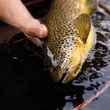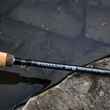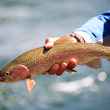It’s easy to love trout or bass. These charismatic fish are the backbone of recreational fishing, fly or otherwise. They’re willing, visually appealing. and they’re appreciable battlers when they’re hooked and fighting for their lives. But they’re not particularly intimidating — most anglers don’t look at a brook trout or a smallmouth and worry about what might happen should they suddenly find themselves in the water with them.
That’s not true with all worthy game fish. Sometimes, the trepidation is because of where the fish live, and what shares the water with them. I have a fascination with the bowfin of the Deep South — toothy predators in their own right. But their habitat is what’s really intimidating. If you haven’t had to fend off a 10-foot alligator with a boat paddle to keep it from grabbing a struggling fish from the end of your line, I might argue that you’ve likely not experienced the thrill of fishing in an environment that can — and often will — bite back.
But sometimes, it’s the fish themselves that inspire a bit of worry. These are the fish for which implements had to be created in order to handle them out of fear that they might take a chunk of flesh with them before we send them on their way. Jaw spreaders. Boga Grips. Stuff like that. Sharks, of course, come quickly to mind, and, I suspect, for most saltwater anglers, a massive barracuda with a mouthful of razor-sharp teeth makes for a bit of hesitancy when it comes time to take the hook out.
But catching these fish can be a thrill, too. And, oh, the places you’ll go on your mission to catch fish with more teeth than sense. Here’s a list to get you started, and hopefully inspire you to seek out some of the world’s most intimidating fish, and experience the thrill of landing and handling some of the most misunderstood creatures on the planet.
Northern pike
Hardly a secret among the gear crowd, the fly-fishing world continues to warm to this boreal predator that provides some of the most dramatic action any angler could ask for. The real appeal of pike is the take. The attack. It’s a full-on mauling — watching a massive northern erupt under a hapless Gurgler is one of those killer, Mutual-of-Omaha-Wild-Kingdom moments that has to be experienced to be completely appreciated. And it doesn’t just attack flies. On a recent trip to Manitoba, we watched a big pike come out of the water and almost grab an unsuspecting black bird from a willow branch hanging over the water.

Certainly, the take can be dramatic on a just-under-the-surface streamer or even the venerable Five of Diamonds lure for hardware chuckers. But a topwater take from a big pike is something every fly fisher, and especially the purists who live for the dry-fly take from a hungry trout, should experience just once. Word to the wise: the teeth are serious, and pike have them everywhere, from the roof of the mouth and even inside the gill plate. Handle with care.
Where to catch them: the Great Lakes and the boreal north, all around the globe. Stocked — legally and illegally — in lakes ranging from California to the Northeast.

Barracuda
Dubbed by many as the “bastard of the flats” for its penchant for tearing apart hapless and exhausted bonefish fresh from a fight with an angler, the barracuda is a stellar game fish in its own right. Any flats angler who’s put in time in the tropics knows that the crafty ‘cuda is more than “bycatch” on a bonefish or permit trip — most of us keep a “cuda rod” at the ready, tipped with 40-pound wire leader and the most obnoxious, shiny, swimmy streamer we can yank out of the fly box.
Not unlike pike, barracudas are lighting fast on the attack — the “eat” happens in the blink of an eye, and before you know it, you’re stretched into your backing as the fish, particularly the big ones, are seemingly headed to blue water. The good news? The run is short lived and usually a one-off. You’ll get your fly back, worse for the experience, of course, and you’ll get that hero shot of you posing with the toothiest inshore beast in the tropics. And “toothy” doesn’t do it justice — a barracuda’s mouth should be registered as a lethal weapon. Unlucky anglers have suffered slashing bites — likely incidental contact as they release bones or other freshly caught game fish. Tales of torn flesh, fingers hanging by sinew and chunks removed from calf muscles abound. This is one game fish that can, and will, bite back.
Where to catch them: The tropics and tropical waters around the globe. Big specimens are common on the Bahamian flats, in Belize and along the Yucatan.

Piranha
Years ago, as a kid living in East Texas, I was terrified by the reported catch of a piranha in Lake Texoma, on the Texas-Oklahoma line. It turned out to be a nefarious tale planted by ne’er-do-wells who’d just watched the 1979 film, “Killer Fish,” a B-movie creature feature about jewel thieves who hide their bounty in a Brazilian lake infested with swarming piranhas. At the time, I was an avid waterskier, and the lakes of northeast Texas were amazing retreats for both water sports, and, of course, fishing. But the notion that a manic school of razor-lipped man-eaters might be lurking under the waters of Lake Texoma was enough to keep me out of the water. I mean, what were we more terrified of in the 1980s than piranhas that could rip your intestines out of your belly? Maybe saltwater crocodiles. Oh, and quicksand, of course.
Underappreciated among the fly crowd, the black piranha and yellow-cheeked piranha of the Amazon basin are excellent fighters and they’ll willingly hit a slow-stripped fly in murky jungle rivers where most of us wouldn’t dare get our feet wet. No, they don’t just eat people for the hell of it, but they are voracious. I’m in the Amazon as I write this, and I can attest to the aggressive nature of these predators. Not only are their teeth sharper than sharp and designed to rip and tear, they’ll absolutely savage an otherwise perfectly good peacock bass fly. But, as a fly fisher, if you come to the Amazon, these fish need to be on your list. Catch one. Hell, catch 20. Here, in the remote interior of the jungle, they get big — 10 pounders are totally doable on a fly. And, if you have the right guide who’s willing to put a shore lunch together, they’re mighty tasty.
Where to catch them: Fly fishers can find piranhas in the Amazon and Orinoco river drainages in Brazil and other South American countries within these river basins. They’re also found in the Paraña River basin that stretches south to Argentina, and in the Sao Francisco River system.

Wolffish
Speaking of the Amazon, I’ve just been indoctrinated into the art of fly fishing for wolffish. All I can say about the endeavor, as I sit in comfort in a great new lodge in the remote heart of the Amazon with a cold beverage in hand after my fifth day spent chasing this incredible fish? Oh. My. God. These massive ambush predators resemble other freaks of piscatorial evolution, like the snakehead, the bowfin, and even the gar. They hide in the rocky crevices or lounge quietly on the muddy flats of South America’s jungle rivers and absolutely explode on unsuspecting prey. Or poppers, Gurglers, or streamers. And they fight like hell.
And teeth? Oh, hell yeah. And, no, they’re not “easy.” They can be forgiving, or, as I prefer to describe them, “determined.” Several times this week, I’ve hooked big wolffish and fought them nearly to the boat only to have them come unhooked (they have very bony mouths and they are tough to keep on the line). Each time, the fish has retreated to its little ambush hidey-hole, and, on more than one occasion, a recast popper or Gurgler incites another vicious strike. At other times, they are inexplicably close-mouthed, and you can put a fly in their face and nothing will happen. Their mouths are lined with short, sharp teeth, and anything they want to keep in their mouths will stay in their mouths. To add to their appeal as a fly-rod target, they just look mean. Where pike kind of wear a sinister grin on their faces, the wolffish’s countenance is more of an evil smirk. And then, it opens its mouth. And, I swear to God, when a wolffish opens its mouth to grab a topwater fly, it sounds like the chops of an angry junkyard pit bull opening and closing.
Where to catch them: Wolffish, also called the aimara, are native to northern South America, from Venezuela, Guyana, Suriname and the Amazon drainage of Brazil.
The rest
There are so many toothy predators out there. Naming as many as I could would no doubt disrespect some of the better known carnivores of the fishy world. Take the musky, for instance. The finicky big brother of the northern pike is a discerning predator, but, like its esox lucius cousin, it sports big teeth, and lots of them. East Coast anglers have a love-hate relationship with bluefish — the reason wire leader exists in the striped bass community. In the American south, chain pickerel are basically miniature pike — the teeth are the same. And don’t forget the gar. Three varieties swim the waters from about Missouri south to the Gulf of Mexico — spotted, long-nose and the massive alligator gar that can be measured in feet and might be more than a century old by the time some lucky angler can hoist it from the water.
Obviously, sharks make the cut, but they’re not typically targeted by fly anglers (unless you visit San Diego). I’ve caught a few sharks on the fly — mostly small ones swimming around schools of bonefish in the tropics, and, while the pay off photo is pretty cool, it’s not my favorite thing. I might honestly prefer to catch Spanish, king, or sierra mackerel — the teeth are pretty cool.
Regardless, the fascination continues. Here in the Amazon, I have one more day to try and catch the legendary payara, known locally as the vampire fish. With massive teeth, this is the fish that, by itself, would likely keep you out of the river. Throw in wolffish and piranha, and I’m plenty happy to be fishing from the boat.
In Africa, the tigerfish is all the rage, and rightly so. These voracious, toothy predators are streamer killers, and for predator hunters, they might represent the summit of fly fishing for toothy carnivores.
The teeth are the appeal — the attraction that comes with the notion that, should they decide to do it, they could inflict real pain on anglers who throw caution to the wind while handling these fish that sport mouths full of laser-sharp weaponry. We are the hunters of hunters — it’s a silly human thing, of course — and there’s something “dangerous” about conquering a fish with visible teeth.
It’s okay to stick with trout and bass. No judgment here. But there’s literally a world of opportunity for adventurous anglers out there who might be willing to go after the weird and the wonderful fish that just happen to have bigger smiles than others. I’m hooked, obviously. And unapologetically. Big teeth. Big fish. Big adventure.






























Comments